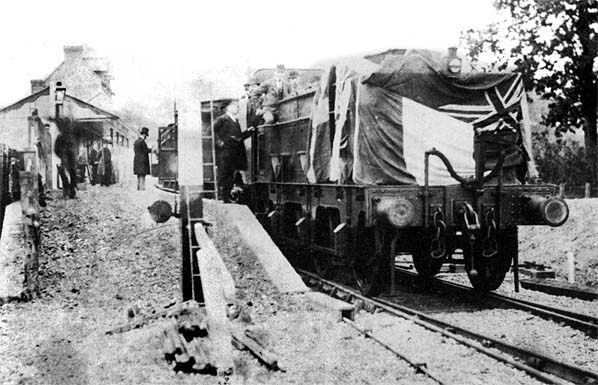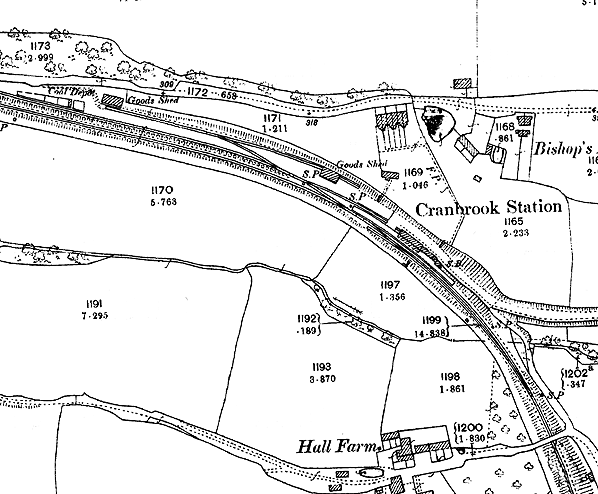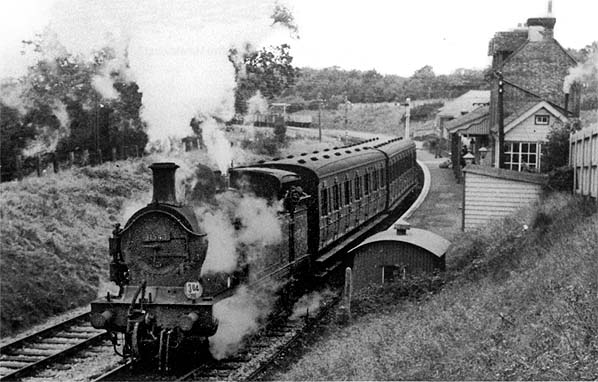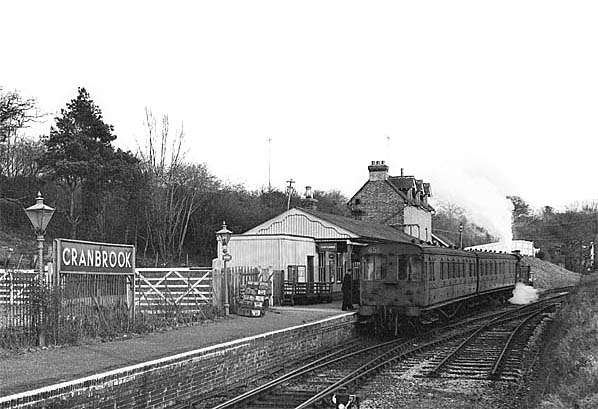
Cranbrook Station Gallery 1 Opening Day - Last Day 

1908 1:2,500 OS map showing the layout of Cranbrook station and goods yard. The yard comprised two sidings, one serving a coal depot at the far end of the yard; at the other end it ran behnd the north-west end of the platform. Unusually for a small station Cranbrook had two goods sheds served by the secons siding. The signal box is located on the platform at the south end of the station building. Six railway cottages are seen to the north of the station.
old16.jpg) Cranbrook station looking north-west from Hall Farm bridge before December 1909. Note the neatly tended station garden on the right.
Copyright photo from John Alsop collection old17.jpg)
Cranbrook station looking north-west c1910. Four railway cottages are seen on the right.
Copyright photo from John Alsop collection
old7.jpg)
Cranbrook station looking south-east c late 1950s.
Photo frm John Mann collection old8.jpg) Cranbrook station looking north-west c late 1950s. The main station building was typical of those designed by Colonel Stephens, single storey corrugated iron with a narrow timber awning resting on five timber posts. The three-storey brick stationmaster's with three dormer windows was also typical of the line. One of two engine sheds at Cranbrook is seen beyond the platform.
Photo frm John Mann collection old9.jpg)
H Class 0-4-4T 31543 is being propelled into Cranbrook station in October 1960. The youing boys on the patform are 'helping' the station master who is standing behind the wooden post. One ius wearing a railway hat amd nother is holding the single line token. 31543 was one of a class of 66 locomotives originally designed for suburban passenger work, designed by Harry Wainwright in 1904. Most of the class were later equipped for push-pull working for use on rural branch lines. 31543 was built in January 1909 at Ashford works and was originally numbered 543. It was renubered to to 1543 by thge Southern Railway with the 3 prefix added after nationalisation. It was withdrawn from Tonbridge Wells West shed in July 1963 and cut up at Eastleigh works the following year.
Photo by HB Priestley 
31543 is again seen, this time pulling out of Cranbrook
station bound for Hawkhurst in October 1960.
Photo by H. B. Priestley 
old10.jpg) 31543 was regularly seen on the Hawkhurst branch as closure approached. Seen here pulling out of Cranbrook station bound for Hawkhurst in October 1960.
Copyright photo from Colour Rail old5.jpg) Stationmaster George Burring, the last stationmaster at Cranbrook c1960. After closure in 1961, George Burring moved to Sandling Junction.
Photo
received from Phillip Hamilton
old6.jpg)
Cranbrook station on a wet day in April 1961, seem from a passing train.
Copyright photo by R M Casserley old13.jpg) Cranbrook station looking north-west from Hall Farm bridge on Saturday 10 June 1961, the last day of public service. Photo by Ian D Nolan, from his Flickr photostream
 Home Page Home Page
|

 Notes: There were several proposals to build branch lines in
the Weald of Kent all promoted by local groups rather than the
South Eastern Railway who preferred to step in at a later stage
to rescue the ailing companies once the money ran out. Most of
the early proposals quickly ran out of steam but in 1864, the
Weald of Kent Railway obtained powers to build a line from Paddock
Wood to Hythe running through Cranbrook and Tenterden. Although
this railway failed to matearilise the Cranbrook & Paddock
Wood Railway was incorporated in 1877 to build the northern section
of the Weald of Kent line between Paddock Wood and Cranbrook.
The line was to be built with local money but the South Eastern
Railway agreed to contribute towards the venture once construction
had started
Notes: There were several proposals to build branch lines in
the Weald of Kent all promoted by local groups rather than the
South Eastern Railway who preferred to step in at a later stage
to rescue the ailing companies once the money ran out. Most of
the early proposals quickly ran out of steam but in 1864, the
Weald of Kent Railway obtained powers to build a line from Paddock
Wood to Hythe running through Cranbrook and Tenterden. Although
this railway failed to matearilise the Cranbrook & Paddock
Wood Railway was incorporated in 1877 to build the northern section
of the Weald of Kent line between Paddock Wood and Cranbrook.
The line was to be built with local money but the South Eastern
Railway agreed to contribute towards the venture once construction
had started  Further delays meant that it was twelve years before the line
was ready for passengers, the first section, from Paddock Wood
to Hope Mill for Goudhurst & Lamberhurst opening on 1 October
1892. Nearly a year passed before the final part of the line came
into service, the extension to Hawkhurst via Cranbrook opening
on 4 September 1893; on the same date Hope Mill was renamed Goudhurst.
Further delays meant that it was twelve years before the line
was ready for passengers, the first section, from Paddock Wood
to Hope Mill for Goudhurst & Lamberhurst opening on 1 October
1892. Nearly a year passed before the final part of the line came
into service, the extension to Hawkhurst via Cranbrook opening
on 4 September 1893; on the same date Hope Mill was renamed Goudhurst. 
 Holman Stephens, later known as
Holman Stephens, later known as  From the outset all train services were operated by the South
Eastern Railway, though the Cranbrook and Paddock Wood Railway
was not officially absorbed until 1900. The SER and the LCDR combined
in 1899 under agreement that both companies would retain their
independence while being administered under a management committee
operating as the South Eastern & Chatham Railway. The LCDR
was itself incorporated into the Southern Railway under the 1923
grouping and finally British Railways after nationalisation in
1948.
From the outset all train services were operated by the South
Eastern Railway, though the Cranbrook and Paddock Wood Railway
was not officially absorbed until 1900. The SER and the LCDR combined
in 1899 under agreement that both companies would retain their
independence while being administered under a management committee
operating as the South Eastern & Chatham Railway. The LCDR
was itself incorporated into the Southern Railway under the 1923
grouping and finally British Railways after nationalisation in
1948. From the offset traffic on the line was light, due in part to
the inconvenient locations of stations. Extra traffic was generated
during the hop picking season which, at its height, brought up
to 26 special trains a day with each train carrying up to 350
people. By 1959 this traffic had declined and the line was carrying
less than 200 passengers a day, many of them children. The final
blow came when the local education authority took out a contract
with the Maidstone & District Motor Company to transport the
children by bus. Despite rumours of electrification, closure was
announced and the line finally closed on 12 June 1961.
From the offset traffic on the line was light, due in part to
the inconvenient locations of stations. Extra traffic was generated
during the hop picking season which, at its height, brought up
to 26 special trains a day with each train carrying up to 350
people. By 1959 this traffic had declined and the line was carrying
less than 200 passengers a day, many of them children. The final
blow came when the local education authority took out a contract
with the Maidstone & District Motor Company to transport the
children by bus. Despite rumours of electrification, closure was
announced and the line finally closed on 12 June 1961. CRANBROOK STATION
CRANBROOK STATION The station's name was a little deceptive in that the town of Cranbrook was two miles away. When the line was originally being constructed, local landowners had demanded high prices for the sale of their agricultural land and the South Eastern Railway had refused, amending the route of the line so that Cranbrook Station was actually located in Hartley. The villagers came to regret being excluded from the line, and an attempt was made to have a light railway constructed to Hartley. This was never realised.
The station's name was a little deceptive in that the town of Cranbrook was two miles away. When the line was originally being constructed, local landowners had demanded high prices for the sale of their agricultural land and the South Eastern Railway had refused, amending the route of the line so that Cranbrook Station was actually located in Hartley. The villagers came to regret being excluded from the line, and an attempt was made to have a light railway constructed to Hartley. This was never realised.
